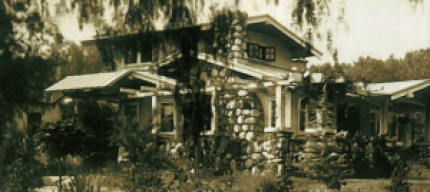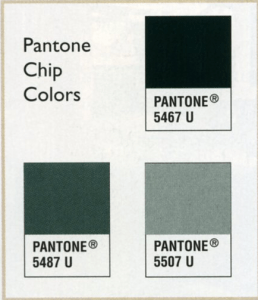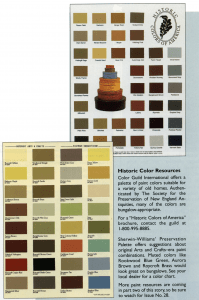By Michelle Gringeri-Brown
From Issue 27

It seemed like a simple paint job. The bungalow that houses our magazine publishing offices had been painted a traditional gray body color with light trim for the past 15 years or so. Pleasant enough, but a bit ho-hum. Its colors didn’t really reflect the Arts and Crafts era, or capitalize on the potential beauty of the airplane bungalow’s architecture. Plus, the paint was virtually jumping off the house in some places, and looked chalky and tired overall.
The question seemed to be, What colors should it next be painted?
Should we conduct research and repaint in the original color scheme? Choose shades from some contemporary Arts and Crafts palettes? Or simply select colors we liked? In reality, the question before us was. What kind of restoration and prep work should be done before applying a single brush-full of new paint? And so the saga began.
Assessing the Condition
Publisher John Brinkmann tapped the resources of local preservation group Pasadena Heritage to try to find the right consultants for the job. Some of the timbers on the front porch were sagging, and sun and rain had done a job on the most exposed sides of the house and garage. The surfaces of many of the window sills were in poor condition, and multiple layers of paint were hiding the distinctive saw pattern on the shingles. Missing rain gutters were also noted as condition problems.
One consultant recommended the extensive use of Abatron, a resin compound, to fill in rot and insect damage to the wooden porch members. He removed some of the worst sections to work on them off-site, but months went by with little progress. A second restoration expert, Mike Hahn, stepped in. He advised filling some of the damaged areas, but suggested replacing other areas with new wood. Since the existing 1914 timber dimensions couldn’t be matched with today’s standard sizes, a circular-saw-cut, custom Douglas fir beam was attached with a straightforward scarf joint. Hahn also tracked down a resource for barn shingles that closely matched the originals, and replaced some rotted and missing areas.
Reading the History
 Brinkmann also turned to existing blueprints and John Snyder, a historical preservationist with the state of California, for clues to the bungalow’s history. “The house was in good condition overall,” Brinkmann says. “It belonged to just one family before I bought it in 1987, and the owner, Mrs. Twycross, invested in high-quality maintenance over the years. I don’t think she considered it to be a classic Craftsman—it was just her home—but she had the foresight to keep the original gravel roof, and much of the interior was nearly untouched. It had original hardware and lighting, and unpainted woodwork in the living and dining rooms.”
Brinkmann also turned to existing blueprints and John Snyder, a historical preservationist with the state of California, for clues to the bungalow’s history. “The house was in good condition overall,” Brinkmann says. “It belonged to just one family before I bought it in 1987, and the owner, Mrs. Twycross, invested in high-quality maintenance over the years. I don’t think she considered it to be a classic Craftsman—it was just her home—but she had the foresight to keep the original gravel roof, and much of the interior was nearly untouched. It had original hardware and lighting, and unpainted woodwork in the living and dining rooms.”
Snyder immediately dated the house to 1914, based in part on the alternating long/short pattern of the cross- sawn shingles, a style that he said was popular from 1914—15. “The blueprints we have are from a 1930 remodel,” Brinkmann explains, “but we also have several earlier photos of the house. John Snyder looked them over and pointed out where the south wall had been pushed out about 10 feet—including the fireplace— which eliminated part of the original wraparound porch.
There were also modest expansions to the back-porch area, and a second downstairs bath as added during this same “period.”
 Snyder helped answer the question of the original colors. using automotive sandpaper, Le sanded two sections, one on the original portion of the bungalow and one on the ‘30s addition. Feathering the edges to show the triated layers of each coat of paint, the original colors were revealed to be cream with a lighter trim. Not exactly what Brinkmann had in mind.
Snyder helped answer the question of the original colors. using automotive sandpaper, Le sanded two sections, one on the original portion of the bungalow and one on the ‘30s addition. Feathering the edges to show the triated layers of each coat of paint, the original colors were revealed to be cream with a lighter trim. Not exactly what Brinkmann had in mind.
“Bringing the house back to its fresh, original statement meant more than just a new paint job,” he says. The texture and saw marks on the redwood shingles were so organic I knew they should be liberated from the coats of paint that had built up. And it was apparent from what John Snyder showed me that they had always been painted.”
So our publisher-cum-graphic designer repaired to his computer.
Color Cues
Instead of caging swatches from his local paint store, Brinkmann turned to a designer’s best friend, his Pantone color book, and a careful scrutiny of the house exterior.
 “The front of the bungalow has a lot of gray, green and blue in the stone foundation and the cement walkways and porch,” he explains. “The house has a kind of New England sensibility to its landscaping, but it’s in a desert atmosphere. Plus, the light-color gravel roof made me think of muted sage colors. All of these elements led to an Arts and Crafts—like gray-green body color.”
“The front of the bungalow has a lot of gray, green and blue in the stone foundation and the cement walkways and porch,” he explains. “The house has a kind of New England sensibility to its landscaping, but it’s in a desert atmosphere. Plus, the light-color gravel roof made me think of muted sage colors. All of these elements led to an Arts and Crafts—like gray-green body color.”
Brinkmann’s approach has a historical precedent, as explained by author Timothy Hansen in “Color and Light from Nature” in Issue No. 6: “Color schemes from nature were one of the most popular Arts and Crafts methods.
First, find something with a color you like—a leaf, a butterfly, a tree fungus, a stone—and analyze its colors. Figure out the proportions of the different colors used, and then apply those colors and proport ions to the object being decorated.”
The oak front door and porch ceiling were warm, varnished natural wood, leading him to search for a complementary brown shade for the window trim. Nothing doing. During his computer color studies, and in actual swatch tests on the house, all of the brown tones Brinkmann tried just didn’t work with the body color he’d chosen. Later, the painter sugg ested a rusty red, and fortunately, that clicked with the rest of the palette.
Bargeboards, knee braces, porch beams and pillars were all lighter versions of the body color for emphasis. And perhaps the boldest, and most successful leap was choosing a deep charcoal for the eaves and the lower portion of the window frames. The dark color emphasizes the 3-D qualities of the architecture, casting what looks like shadows, whether the house is in full sun or shade.
 With the colors selected, and the repairs underway, all that remained was to find a painter who understood the nuances of a project of this scope. Someone who knew and loved old houses, who could recommend products and techniques that would allow the 80-plus-year-old bungalow to emerge from behind its innocuous overcoat. A relatively simple task, right? Aah.. . stay tuned for our next installment to see what challenges our noble painter faces.
With the colors selected, and the repairs underway, all that remained was to find a painter who understood the nuances of a project of this scope. Someone who knew and loved old houses, who could recommend products and techniques that would allow the 80-plus-year-old bungalow to emerge from behind its innocuous overcoat. A relatively simple task, right? Aah.. . stay tuned for our next installment to see what challenges our noble painter faces.
RESOURCES
John Snyder
RS. Preservation
Service
Sacramento, CA
(916) 488-7641
Consults on period color, National Registry nominations, and other architectural preservation concerns.
Michael Hahn
General contractor
Covina, CA
(909) 595-5574
Renovation, remodels, new construction.
